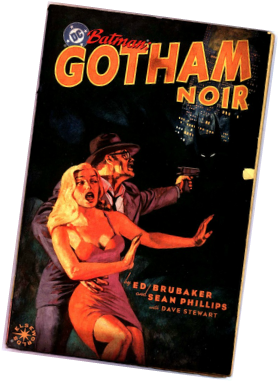 This week we have another DC Elseworlds comic review, namely Ed Brubaker's “Batman Gotham Noir”, and just like any noir comic, this one has that sense of morbidity and darkness in every panel.
The story is simple enough. Batman's police ally Gordon is set up and is framed for the murder of Rachel Hollingsworth, after he is drugged at a boat party. The corrupt mayor, who has ties with the dead girl, blames Gordon's drinking problems and paints him up as a killer cop.
Thus, the entire story is more about how ex-cop Gordon has to clear his name. Even thought Batman does play a role in it, he is obviously not the main character. As a true lover of noir, this reader found Gotham - set in the dark and grimy atmosphere associated with the genre - to be the most appealing part of the novel. The artwork complements the writing and the Bat is depicted as a blurry shape in the darkness. The disappointing bit is that the story didn't stray far from any other clichéd noir story. Cop/Hero falls in love/given duty to take care of beautiful lady with elegant dress. Cop/Hero is framed, runs from police, shoots everything in path to clear his name/save his family/save his love.
However, Ed Brubaker does make up for his clichéd storyline by adding tidbits from Batman's original story. He uses Harvey Dent and shows him to be the helpful and resourceful DA he was before he turned into Two-Face. He also depicts Selina (Catwoman) as a close friend of Gordon. The most interesting bit of the story was that somehow he managed to include The Joker in it, too. Even though his character's inclusion is short lived, The Joker still plays a part in the story.
A must read for all Batman fans. Should be an entertaining read for non-fans, as well.
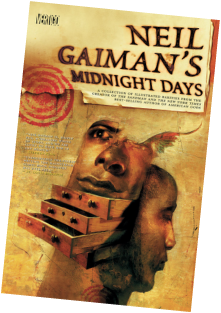
Neil Gaiman is one of the most talented and imaginative writers of the modern day. And that is the extent of breathless gushing I want to do in this review. Midnight Days is one of those books that could easily have never seen the light of day. It collects 5 of Gaiman's earliest works for Vertigo. Those who expect the fantasy writer at the top of his game, will be disappointed. This is more of a collection to show Gaiman's foundations, how he started out. The introductions he wrote alongside the stories are fascinating, and offer some history onto how he started out in the comic business.
The first story, Jack in the Green, is interesting primarily because it sees a reunion of the original artistic team that worked on Alan Moore's now classic Swamp Thing. This also happens to be only the second story Gaiman had written (the first being a Hellblazer title about what's growing in John Constantine's fridge). I'm not very literate on Swamp Thing, but even then, there's not much in the story. It's pretty, poetic prose. The artwork is very good though. Considering it's only the second story he'd ever written, you can see the specks of talent waiting to shine through.
Brothers is about a rag doll animated by forces similar to the ones behind the Swamp Thing. The story is surreal, bizarre,twisted and any other synonym you can think of. I liked this stora lot. The characters are brilliant. There's the innocently-psychotic rag doll that's exposed to an alien world, the ever optimistic hippie enamoured by flower power and the cynical FBI agent, disillusioned from the summer of love. A brilliant mesh of personalities creates a memorable story.
Shaggy God Stories is kind of like the first story. Again, you really have to be very Swamp Thing literate for this to really appeal to you. Instead of Swamp Thing, this time it's about the Floronic Man (yeah, Gaiman has some weird vegetable obsession). Hold Me, commonly known as Hellblazer 27, is what Gaiman describes as one of the best comics he's ever written. I think I might agree. The exceptional Dave McKean does the art and it's probably the best McKean work I've seen. The story is very touching (darn near gets you all teary). It's sombre, dark, a collage of loneliness and how a forlorn spirit finds some solace. Definitely the high point of the collection.
And this brings me to the last story, Sandman Midnight Theatre. Long before I got my hands on Midnight Days, I heard about a story where Sandman (Morpheus) meets the Golden Age Sandman. So when I did finally get to this story, I was buzzing. This story also happens to be a collaboration between Gaiman and Matt Wagner, the original writer of the Golden Age Man of Mystery, Sandman. Teddy Kristiansen does a wonderful job with the art too. The story, though, focuses mainly on Wesley Dodds, as Morpheus was still locked up in Burgess' glass prison (which you already knew if you've read Preludes and Nocturnes). Does it live up to the hype? Well, I think it did. Check it out and find out for yourself.
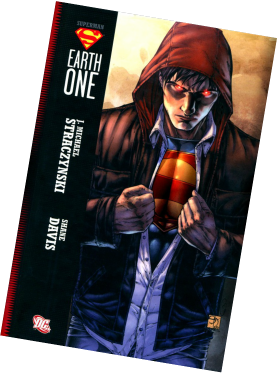 After 72 years of the Man of Steel, flying in to save the day, beating the cartoon daylights out of crooks and standing tall in his underwear over pants and saviour of the world posture, the world wouldn't possibly need to know anything more about Superman. However, in Superman Earth One, J. Michael Straczynski writes a Superman origin story which turned out to be so brilliantly distinguishable from the original that its quite surprising. It still managed to hold the essence that was the Man of Steel when he was first thought up so long ago, which is admirable.
The characters are all recognizable in mind but not so much in physical appearance. The talented Shane Davis gives the age old characters a modern mix to make then resemble ordinary every day people; he does so with marvellous depth as the characters still look the same, but with just enough of different details to make them stand apart from the original.
Clark is seen as a young man of twenty something years, with a lot on his mind and a different approach to tackling Metropolis. Straczynski's story hits a different tune than the original in the sense that Lex Luthor, the main villain of every Superman story, has been replaced with an alien army turning Earth into a wasteland in search of the last son of Krypton.
Of course, Superman will swoop in and save the day, but this novel is more than just a modern realization of the old tales. It's a completely new twist to the Superman saga and J. Michael Straczynski has done it with superb story telling.
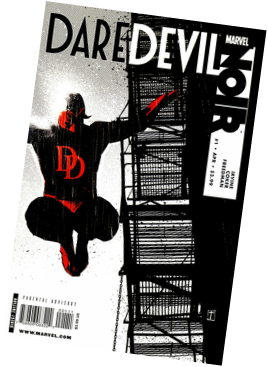 “To know the end of a story, you have to know the beginning”
Written boldly by Irvine and made visually superb by Tom Coker's artwork, Daredevil Noir is an end from a Marvel Elseworld cover of the man without fear so superb that it could stand as a strong testimony to the original Daredevil.
This novel takes blind Matt Murdock to a Hell's Kitchen subjected and victimized under the rule of old nemesis, Kingpin. The climax triggers when a beautiful woman shows up at the door of his and his lawyer friend Foggy Nelson with a new case which pulls Daredevil into a fight between the current boss Wilson Fisk (Kingpin) and the upcoming rising star Orville Halloran.
The artwork is perfect, only the colouring challenging it, as every shade of black for the night sky, and every shade of blood red for the lipstick on the damsel's lips is done to be easily spotted and appreciated. Irvine's writing seems strong from start to the end, as the story grips the reader and doesn't let go until the last page is turned.
The best thing about the novel is one whose existence can be credited a bit to the author and a lot to the mythology behind Daredevil. The Daredevil universe consisted of a blind man, jumping off buildings and fight bad guys at night and hobbling with a cane in the mornings; that, and the intricate attention to the details of this mortal man's experiences throughout Hell's Kitchen, the Daredevil world was already very much in the 'noir' setting. Thus, this Marvel version of Elseworld was a better fit than any other Marvel title.
All in all, it's a great novel and it's also a one-shot, so even if you've never real a single Daredevil issue in your life, you still won't get lost.
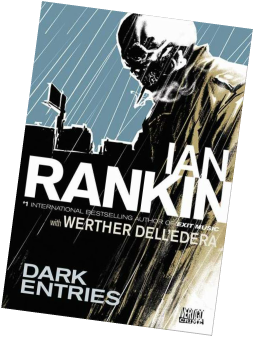 You don't seem to be tuned in, Mr. Constantine”
John Constantine is one of the biggest badasses in comic books. The rugged demeanour, the trench coat and the perennial cigarette in mouth, Vertigo's stalwart supernatural investigator ranks highly in the list of coolest ever comic characters. And it is John Constantine that mystery writer Ian Rankin chooses to revolve his first try at writing comics around.
Dark Entries, one of the two books released to launch the Vertigo Crime line, is a satire on shows like Big Brother and an assault on the hellish world of reality television. If you haven't guessed yet, the story consists of our occult getting himself trapped on a reality TV show. Dark Entries is a rehashing of the classic haunted house scenario, with a large dash of mockery directed towards celebrity culture thrown in. The plot consists of a haunted house game show where the house has seemingly grown a mind of its own and is scaring the contestants – who are the usual combination of geeks, foreigners, tattooed troublemakers and a pretty damsel in distress. After a walk in the celebrity obsessed streets of Anytown, England, Constantine runs into an offer from a mysterious network executive to join in the show as a “consultant”.
The story is hackneyed, but enjoyable. Unfortunately for him, it's overshadowed by the Hellblazer from the near 300 issues released so far and Jamie Delano and Garth Ennis' works. Constantine is not as quick-witted as we know him to be, and he seems too gullible as he jumps to accept a hefty payload and dubious offer from aforementioned mysterious network executive. That being said, Rankin chooses to focus on what he's good at and what he knows how to do. He zeroes in on Constantine's sleuthing skills. The result is a character that is still familiar to long time readers and one that is instantly appealing to newer ones.
Dell'edera's art is very different. You don't often see this type of art in the mainstream DC or even Vertigo titles. It's got an indie feel, the black and white sketching perfect for the crime/suspense genre they're trying to go for. An interesting quirk to the book is how half the pages are white and half are black (turning black after one of the big plot twists).
The dialogue is pithy and sharp. The story is outdated but fun. It's a decent read. Get it if you hate reality television as much as John Constantine does.
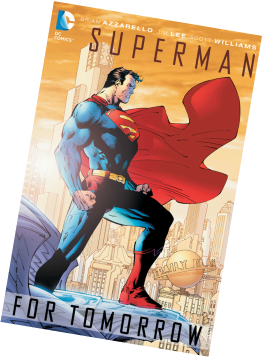 When it comes to these usually nine paneled animations on paper about interesting folks in latex, I am by all definitions of the term, a “purist”, and when it comes to men with superpowers, there's no one better in my eyes than the Man of Steel. Thus, a Superman title penned by legendary 100 bullets magician Azzarello and drawn for by none other than Batman: Hush's prolific Jim lee, is a title too precious to miss out on.
However, after the purchase of the two novels that make up this arc, the eye catching hardcover art and even Jim lee's attention to detail did little to make up for the disappointment that the book eventually turned out to be. The story concerns a disappearance of more than a 100 people all over the world, one that Supes can't do anything about considering he's out in space during that time. As the story unfolds, more and more details about the disappearance is revealed, and like truths about mysteries, this revelation about the cause of the disappearance was much less exciting than the disappearance itself.
In the pages, Superman sometimes appears too similar to Lee's previous work on Bruce Wayne in Hush and even though Wonder Woman and Lois Lane's beauty is portrayed through what can be easily identified as 'generic features', the artwork still manages to impress. There is not much that Lee does wrong, as compared to Azzarello.
It's obvious that Azzarello tries a new twist to the 70 year old icon and it's easy to appreciate his attempt as well, but in the end, it doesn't feel like a Superman novel. Azzarello isn't the type of author to spoon feed a story, and it shows in the novel, however, the story does get a little too confusing at times.
The only reason why anyone should buy this is the reason why Azzarello takes the blame for ruining a Superman arc. In trying to get another angle on Superman's adventures, Azzarello manages to create a completely new side of the man of steel. Superman is inevitably immortal to everything and so the character could be boring sometimes, but the Superman Azzarello writes up isn't just a man of steel with ultimate power and no weak points. This novel shows the readers the answer to the question “what happens when Superman fails?”
Although volume two gets progressively bad, the first few issues in volume one are golden. Reading about Superman flying into church to confess and find solace in a priest is something I personally found fresh and perfect. Rather than being the everyday superhero, Azzarello shows us that the man of steel is more human than alien.
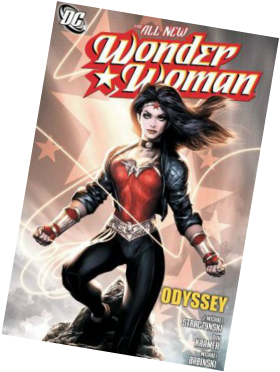
Last year, Straczynski opened the comic book world to old familiar worlds with new elements, as he rethought and rewrote Superman and Batman's origin stories to fit his perspective of the modern world. These Earth One stories were a huge hit, and thus, I picked up Wonder Woman Odyssey in hopes of similar brilliance, and it feels safe to say that I was left pretty satisfied.
This being the first Wonder Woman story I had read, it was a perfect start, as Kramer's artwork doesn't falter too much, and the plot deems itself interesting and worthy of appreciation. Straczynski's reinvention of Wonder Woman doesn't just include the same lofty story with a few modernized elements; rather, it's a completely different story with just the necessary amount of familiar backgrounds and new villains, allies, and even costumes.
The story pits Wonder Woman as a young woman on Earth, fresh off the boat, with her last sight of her home island being that of it destroyed, ruined and burned by men. As Diana rises from the ashes and attempts to grab a hold of the hero she is meant to be, she faces the intricate and arduous challenge of finding her mother's killer and seeking to avenge her people.
Straczynski manages to capture Diana's character in a different light, as it's made obvious that Diana wasn't just the usual “flying super-powered 21-year-old” but a girl who had stepped in and had big shoes to fill as a queen. Don Kramer(who's art was a first for me) does a splendid job as the colours come at the reader brightly and the details are instantly recognized by the naked eye, whether it's the reflection of Diana on the gleaming sword as a charging centaur attacks, or the individual beads of perspiration on her forehead as she faces attackers amidst a fire.
The fact that Straczynski does well in holding attention as his story trails off right on the edge, is cemented by this earnest feeling of anticipation about the second volume that builds up in me whenever I catch a drift of the name Wonder Woman. All in all, it's a great novel to learn about the origins of a great superhero.
|







 RSS Feed
RSS Feed